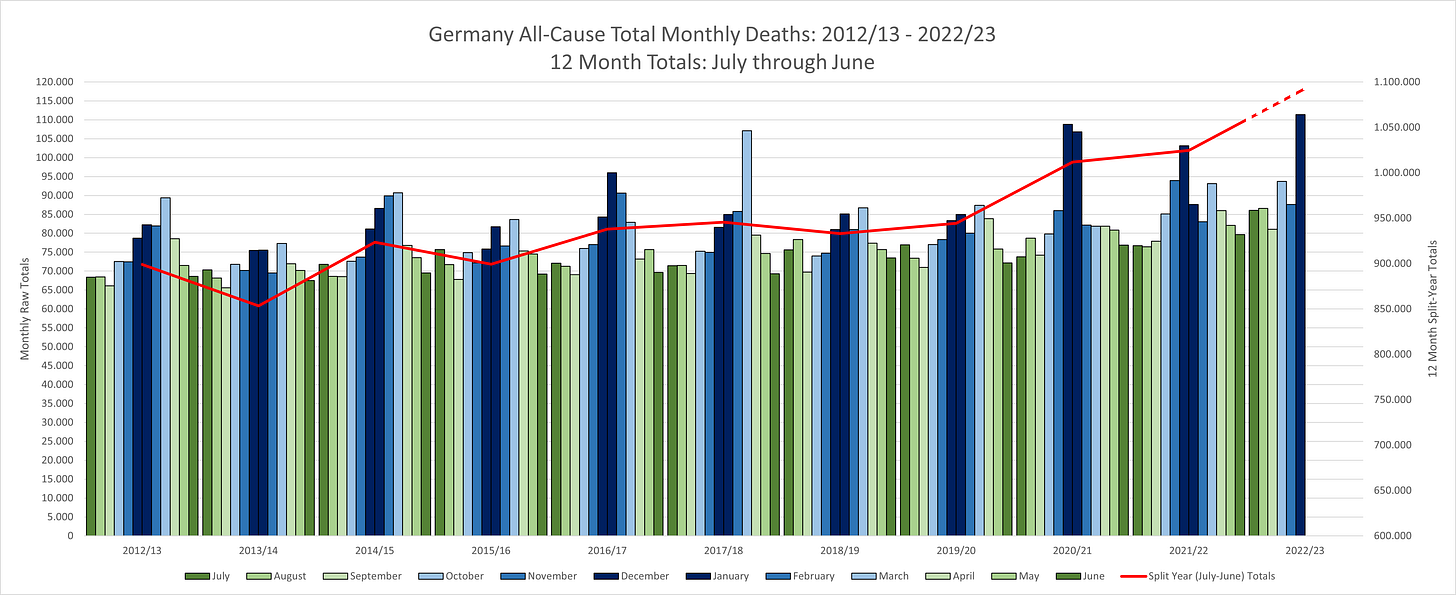
Recap: The MSM continues to ignore the increased excess mortality seen in Germany and in many other countries around the world in 2022 (see previous post: Record-High German Deaths). The primary reason this increase is so concerning is that these excess deaths are reportedly not from Covid-19 and the so-called pandemic is reputedly over. In which case, we should have expected a post-pandemic decline in excess mortality for 2022 or at the very least a plateauing. I would like to draw attention in this post to a phenomenon that may be exaggerating the extent of the increase in excess deaths most recently reported.
As mentioned in numerous tweets and substack posts, Germany, England and many more have seen particularly sharp rises in year-on-year mortality for the last quarter 2022. I have been wondering if a change in the traditional seasonality of other viral epidemics such as the flu may be an overlooked factor in the unexpected recent excess death increases. See this very interesting article in Science on the NOT well-understood seasonality of viruses - SICK TIME - Dozens of diseases wax and wane with the seasons:
Even for well-known seasonal diseases, it's not clear why they wax and wane during the calendar year.
At least 68 infectious diseases are seasonal, according to a 2018 paper by Micaela Martinez of Columbia University. But they’re not in sync, and seasonality varies by location.
Martinez is studying another theory, which Dowell's paper posited but didn't test: The human immune system may change with the seasons, becoming more resistant or more susceptible to different infections based on how much light our bodies experience.
Here is the influenza surveillance data for Germany for the past eight winters from the Global Influenza Surveillance Response System (GISRS)1:
Viral Interference
The first and most striking element of the above chart and one of the many curious aspects of the pandemic is the near global disappearance of influenza during the pandemic winters 2020/21 and 2021/22 only to resurface in early 2022 just as SARS-Cov-2 was apparently receding - I recommend Julius Ruechel’s post The Mystery of the Disappearing Flu for a great overview. See also many fine posts discussing viral interference and Hope-Simpson from Eugyppius:
eugyppius: a plague chronicle - Towards a General Theory of Corona and Why No Interventions Ever Seem to Work As Intended
eugyppius: a plague chronicle - After three years of studiously ignoring obvious patterns, The Science inches closer to acknowledging that viral interference is a thing
Winter Peaks
Equally curious is influenza’s early appearance this winter. The comparison graph below2 shows the influenza sureillance data for the period 2015-2023 (years depicted start in week 40). Here it is clear that influenza season in Germany has been consistently peaking early in the calendar year in February (plus or minus some weeks). In stark contrast, the influenza wave just seen in Germany this winter (light pink line left side of graph) seems to have already peaked before the end of the calendar year in December.
Note also the second comparison showing 2021-22 (darker pink line) with prolonged elevated proportion of ARIs for most of 2022 (since week 13) and how this may have contributed to excess deaths. Has Corona shifted and altered the annual German flu and peak deaths season?
From the bottom half of the graphic, I looks like when influenza’s proportion of acute respiratory cases peaks that it matches reasonably well with peak monthly deaths for the selected time range above. Recall these monthly deaths totals from my post Record-High German Deaths and compare with the influenza surveillance above
(EDIT: have added calendar year totals for comparison in previous post. Added dashed line for winter 2022/23 to show this includes estimations for Jan-June 2023):
Unsurprisingly, we see peak monthly deaths occur consistently in the colder winter season with January-February typically the coldest months in Germany. Interestingly, during the pandemic winters of 20/21, 21/22, and now 22/23, peak monthly deaths has occured in December, while pre-pandemic 2012/13 - 2019/2020 it was most commonly January or March, whereas prior to that in 2007/08 - 2011/12 it was more often December/January. So variation in the month for peak-deaths is normal and I suspect it is also highly connected with temperatures, weather conditions, and sunlight.
Because calculations of excess mortality are dependent on expected deaths, changes in flu season patterns and associated deaths will affect expected deaths and can affect year-on-year comparisons made for individual weeks, months, or calendar years. This is one reason why it is preferable to center the mortality year around a single winter for better comparability and why we need to wait for the death figures for the remaining winter months to make any definitive proclamations about the excess mortality we are currently witnessing this winter. Indeed, we may yet (hopefully!) see a spring of deficit deaths. Alternatively SARS-COV-2 may sweep in to reclaim the space left by retreating influenza.
Current weekly deaths in Germany3: (KW = Calendar Week, dashed lines include estimations)

And here is the latest respiratory virus surveillance data for Germany4 which again indicates this particular winter wave has already peaked in calendar weeks 48-50. It appears to have been mostly influenza type A H3N2 driven, although RSV has been more prevalent amongst the very young.

Note, I am not saying all excess deaths minus covid-19 deaths must be flu-associated, but rather that shifting seasonality trends may be playing an additional unexpected role in the extent of excess mortality seen in December in Germany. Make no mistake, and as I made clear in my previous post, I fully recognise that excess mortality last year was not restricted to the winter months but was year-round and even increased as the year progressed.
Vaccinated Population - Living with Virus
Consider the case of England with the following graphics showing weekly case, test, and test positivity data from GOV.UK Coronavirus (COVID-19) in the UK5 (cases look low in first wave only because testing was extremely limited):
In summer 2021, well before England’s “Freedom Day” on 19 July when the remaining lockdown restrictions were lifted following the vaccine rollout, cases climbed once again and have never fully subsided since. Before anyone shouts “but cases are dependent on testing” - I agree, but please note the test postivity curve which offers a very good second measure of prevalence. Positivity has also never quite subsided since summer 2021 despite doing so in the lulls of summer 2020 and spring 2021 after the initial waves. Although testing has fallen sharply to much lower levels since spring 2022, positivity continues to oscillate in the 5~10% range suggesting much higher incidences than have been recorded by limited testing.
And now comes the deaths graph produced weekly by the UK Office for National Statistics (ONS)6 which has fascinated since summer 2021:
Total (all-cause mortality) weekly deaths have stubbornly refused to subside and revert to normal levels since summer 2021 after the rollout of the so-called vaccines in the first half of the year. There was admittedly a brief respite in the first quarter of 2022 - the closest we came to seeing a post-pandemic swing to deficit deaths (as the graphic states, the deficit is somewhat exaggerated by the inclusion of 2021 figures in the average).
Below I have tried to reproduce the same graphic for Germany based on weekly deaths data available from Destatis7. Note, whereas ONS uses a rolling 5-year average, I have tried to somewhat account for the pre-existing upward trend and used a pre-pandemic 3-year average for 2017-2019 adding 250 deaths per week per year to crudely account for an upward trend. Also, although Germany’s population (~84 million) is larger than England and Wales (~59 million) it has suffered fewer Covid-19 deaths and comparatively much fewer per population.
A very similar pattern emerges: no excess deaths after initial waves with Germany even experiencing deficit deaths in the immediate aftermath of those waves. Just as with England & Wales, total all-cause weekly deaths have stubbornly refused to subside and revert to normal levels since summer 2021 after the rollout of the so-called vaccines in the first half of the year.
Waves that crash - Waves that keep rolling
The initial Covid-19 waves are clearly recognisable as waves: they rose, crested, and fell again to neglible levels. Yet in England 2021, in the middle of summer, cases unseasonally shot up again to winter levels! The MSM repeatedly attempted to assuage any concern by assuring us that hospitalisations and Covid deaths were NOT climbing correspondingly as they had in the previous waves and that this proved vaccine effectiveness. Perhaps, but what has horrified me most is that all-cause deaths did climb above normal levels and have thereafter not subsided - the new normal?
It could also be likened to a forest fire: the first waves raged furiously, burning through all dry wood available but ultimately exhausted themselves (I do not accept lockdowns or other non-pharmaceutical interventions played any significant role in extinguishing the forest fire curves). However, since summer 2021, a low level burn has persisted. It did not spike (until last month) and thus failed to trigger screaming MSM panic levels but neither has it subsided to normal pre-pandemic levels. It just keeps burning. Has the baseline level of mortality been raised?
Follow-up post:
As ever, I appreciate any and all feedback and lease share this post with others who may appreciate it:
On Twitter I am Witzbold @_shloka if you want to follow my tweets.














Excellent! I particularly like the reproduction of the ONS diagram for Germany.
Nicely put together observations. However the missing link is Vitamin D3. It is well known that there is a seasonal variation in serum levels of Vitamin D3 and this correlates with the frequency of winter illnesses and even depression. What is not so well know is the Spanish research into Calcifediol - 25(OH)D3 and its ability to prevent admissions to ICU and death given intravenously. The average serum level of D3 in the population is only 40 nmol/L despite the number of sunny days. This is way below the French lower reference level of 75 nmol/L. At this level the D3 blocks the cytokine storm generated by the spike protein and ensures the naso-pharyngeal surfaces contain two proteins in the mucus, one that destroys infectious bacteria the other viruses.
I think the lack of a healthy immune system is a factor in this seasonality.